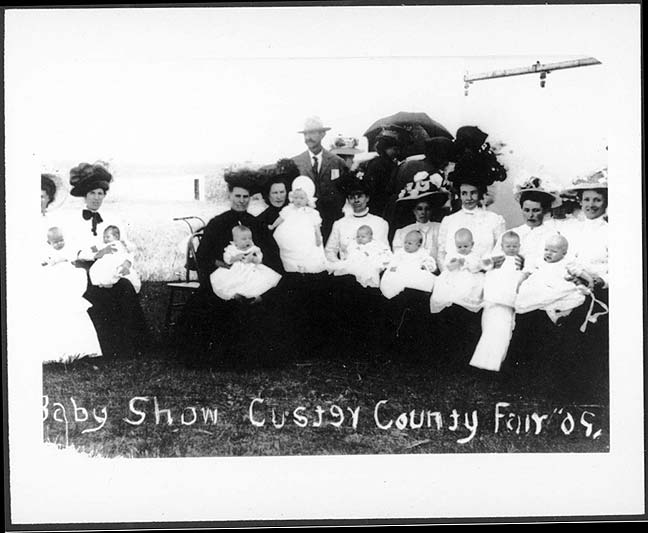The photograph above, from the Solomon D. Butcher Collection, depicts a group of babies and young children in Broken Bow in 1903. Although the event at which they appeared is not identified, it was probably the Custer County Fair, held in Broken Bow, September 1-4, 1903, which included a baby show among its advertised attractions. Butcher was at the fair, where he photographed the Hygeia Creamery Company display. The structure in the upper left of the photo appears to be a fair tent. Lawyer Alph Morgan, at left, was posing one of the children when Butcher caught him in the picture.
Baby shows were once a staple of state and local fairs and church festivals in Nebraska. Even private businesses hosted them to draw paying customers into their stores. Reports of such events, which often included the awarding of cash or other prizes to competing youngsters and their mothers, can be found in newspapers from both large and small towns.
The Columbus Journal on September 23, 1891, reported that a baby carriage was awarded to the winner of a baby show at the recent Platte County Fair. The McCookTribune reported on October 28, 1892, that a contest held at a St. Patrick’s Church fair awarded a silver goblet to McCook’s most beautiful baby. The Omaha Daily Bee reported other such events from around the state. An 1889 contest sponsored by Omaha’s Temple Israel used spectator voting to determine “which of two baby candidates is the most popular among the people of Temple Israel.” A baby show was planned for the 1889 Adams County Fair, and Nebraska Governor John Thayer was invited to judge. The 1893 Douglas County Fair included a baby show with forty entrants. Names of the judges were kept “a deep secret until the time of the contest, in order to keep them free from the preliminary lobbying of the ambitious mothers.” A baby show planned for the 1895 Nebraska State Fair promised prizes for the “prettiest, ugliest and brightest baby.”
A baby show on an ambitious scale, the “Grand Omaha Baby Show and Musical Festival,” sponsored by the New York Exhibition Company, was scheduled for the week of October 16, 1893, with an invitation to the ticket-buying public to attend. Admission fees were twenty-five cents for adults and fifteen cents for children under ten. Babies (under three years of age) registered for the show and their parents were admitted free. Prizes were to be awarded according to the number of coupons or votes that members of the paying public awarded the different infant contestants. The “Handsomest Mother” at the show was also to receive a prize.
The Bee said on October 17, 1893: “There’s a baby show on the boards down in the Omaha Guards’ armory on Capitol avenue. Everything points to the fact that it is bound to be a ‘howling success.’. . . The young hopefuls commenced to gather with the going down of the sun and kept up the procession for fully an hour. They arrived singly, in pairs and by threes, with a promise that quadruplets would be on hand in a day or two. There were fat babies, lean babies and medium babies; there were blonde babies, brunette babies; babies with dark hair and babies with light hair; there were babies at the breast, babies in dresses and babies in pants, . . .
“[T]hey are there from 2 until 5 o’clock in the afternoon and from 7:30 to 9:30 o’clock in the evening, and during all these hours sweet music is discoursed by either a brass band or a pianist, which music effectually drowns the infantile cries and soothes the nerves. Manager Fulton of the baby show received a telegram last evening from Postmaster Lucas of Paxton, Neb., stating that two sets of triplets and their proud mothers were enroute to Omaha to compete for prizes at the infantile exhibit.”
After the turn of the century the popular baby shows were affected by growing interest in child development and concern over high infant mortality in the United States. Contests to select “Better Babies,” such as the one held at the Nebraska State Fair in 1914, reflected these new trends in which young children were examined and scored for points according to standards of weights and measurements.
(Published August 2012)





